battery PONTIAC GRAND PRIX 2004 Owner's Manual
[x] Cancel search | Manufacturer: PONTIAC, Model Year: 2004, Model line: GRAND PRIX, Model: PONTIAC GRAND PRIX 2004Pages: 432, PDF Size: 2.99 MB
Page 331 of 432
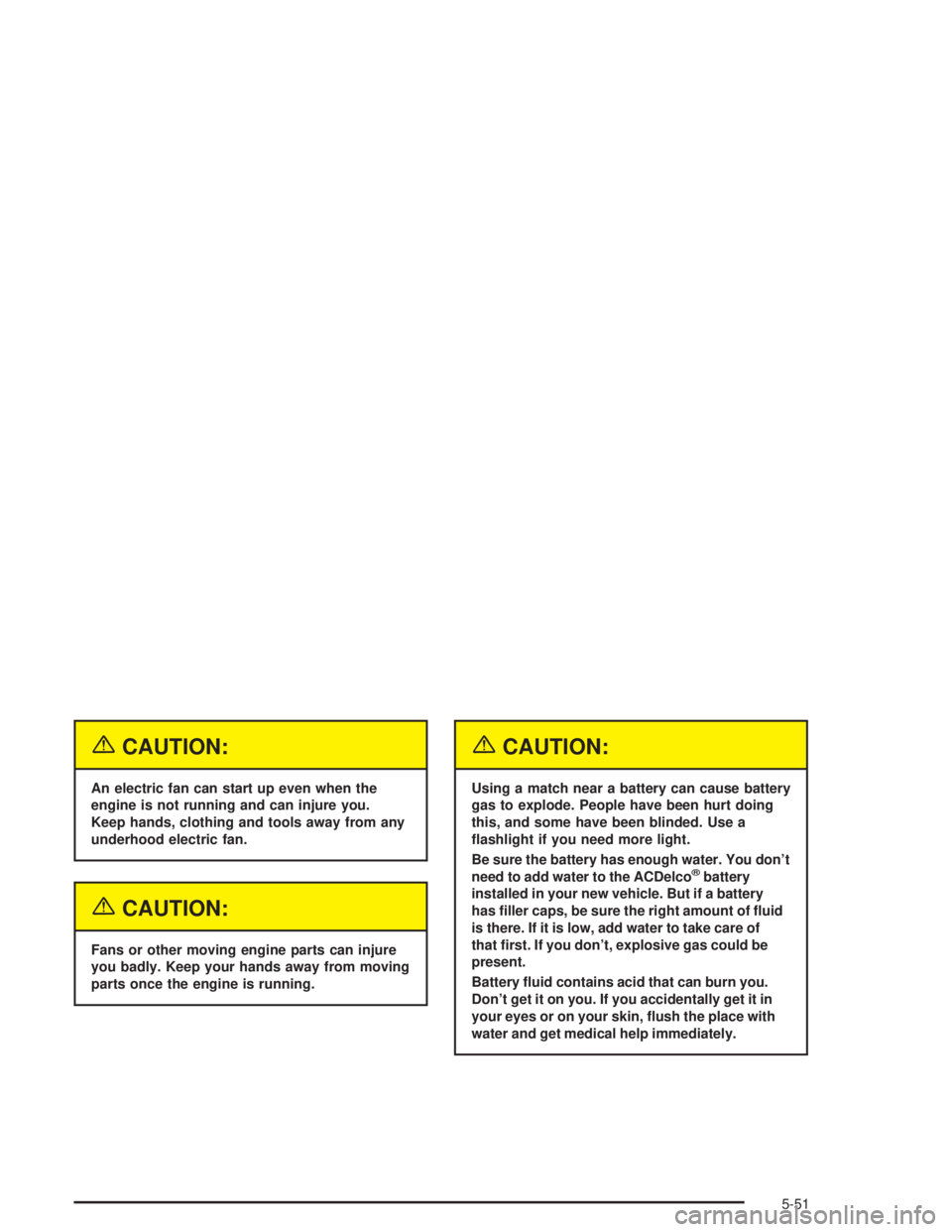
{CAUTION:
An electric fan can start up even when the
engine is not running and can injure you.
Keep hands, clothing and tools away from any
underhood electric fan.
{CAUTION:
Fans or other moving engine parts can injure
you badly. Keep your hands away from moving
parts once the engine is running.
{CAUTION:
Using a match near a battery can cause battery
gas to explode. People have been hurt doing
this, and some have been blinded. Use a
¯ashlight if you need more light.
Be sure the battery has enough water. You don't
need to add water to the ACDelco
žbattery
installed in your new vehicle. But if a battery
has ®ller caps, be sure the right amount of ¯uid
is there. If it is low, add water to take care of
that ®rst. If you don't, explosive gas could be
present.
Battery ¯uid contains acid that can burn you.
Don't get it on you. If you accidentally get it in
your eyes or on your skin, ¯ush the place with
water and get medical help immediately.
5-51
Page 332 of 432
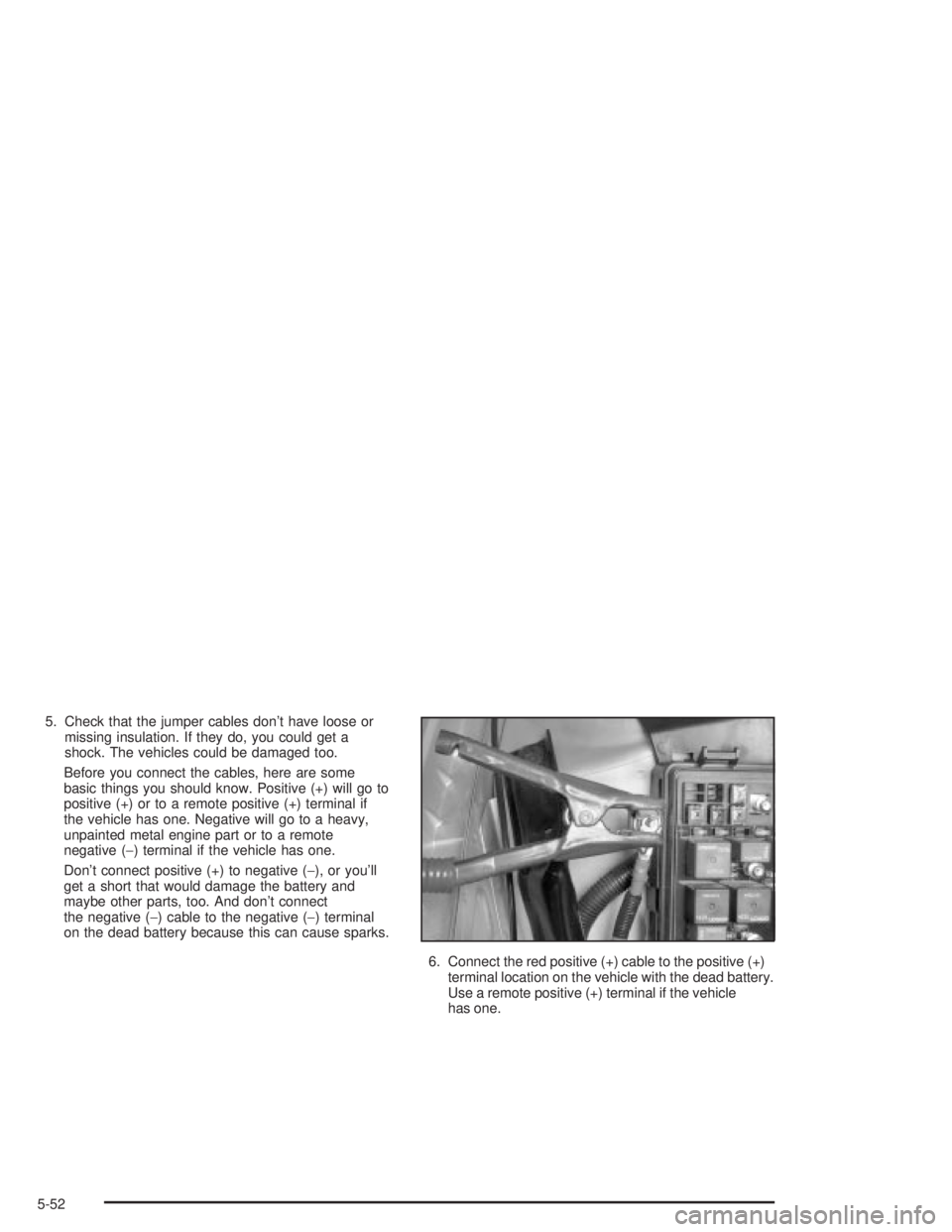
5. Check that the jumper cables don't have loose or
missing insulation. If they do, you could get a
shock. The vehicles could be damaged too.
Before you connect the cables, here are some
basic things you should know. Positive (+) will go to
positive (+) or to a remote positive (+) terminal if
the vehicle has one. Negative will go to a heavy,
unpainted metal engine part or to a remote
negative (-) terminal if the vehicle has one.
Don't connect positive (+) to negative (-), or you'll
get a short that would damage the battery and
maybe other parts, too. And don't connect
the negative (-) cable to the negative (-) terminal
on the dead battery because this can cause sparks.
6. Connect the red positive (+) cable to the positive (+)
terminal location on the vehicle with the dead battery.
Use a remote positive (+) terminal if the vehicle
has one.
5-52
Page 333 of 432
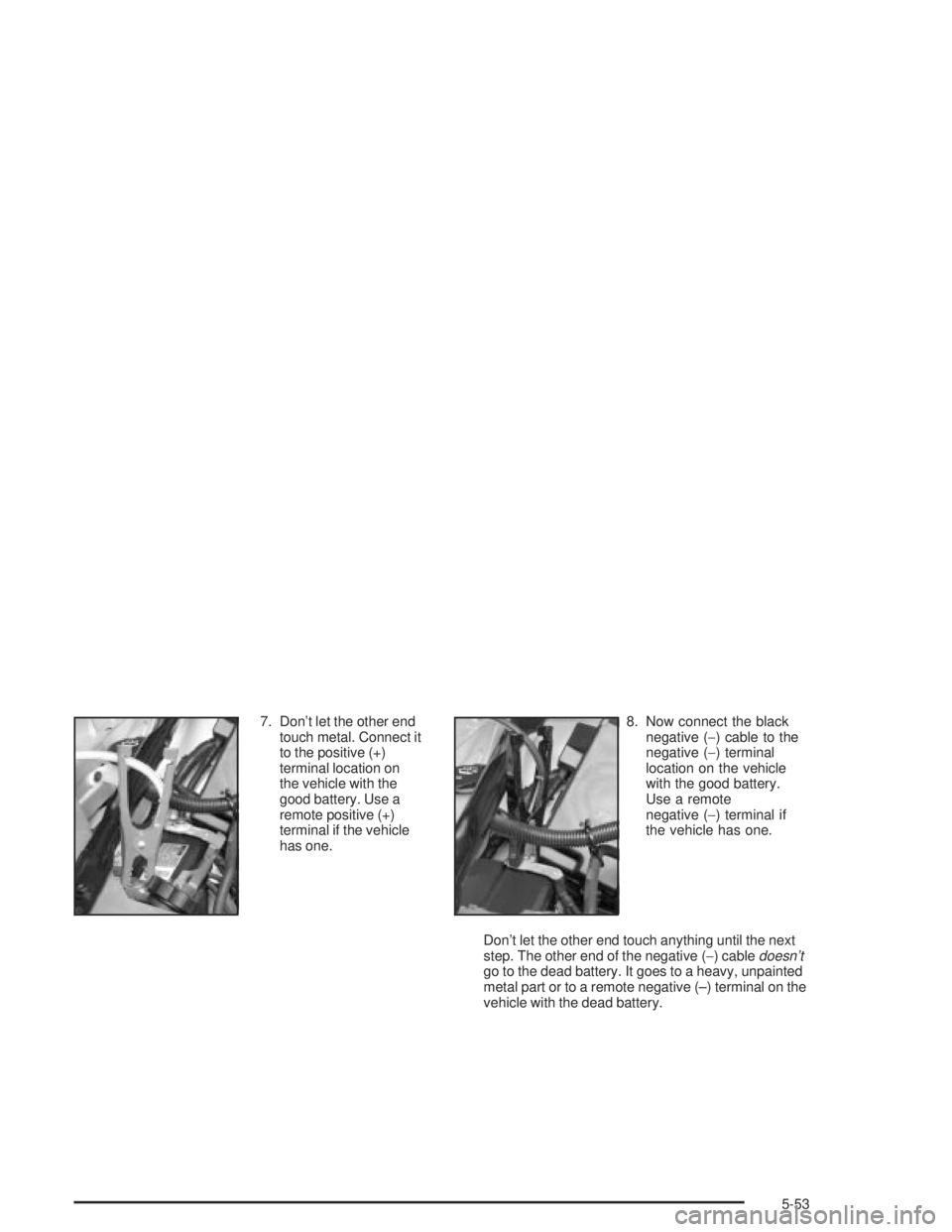
7. Don't let the other end
touch metal. Connect it
to the positive (+)
terminal location on
the vehicle with the
good battery. Use a
remote positive (+)
terminal if the vehicle
has one.8. Now connect the black
negative (-) cable to the
negative (-) terminal
location on the vehicle
with the good battery.
Use a remote
negative (-) terminal if
the vehicle has one.
Don't let the other end touch anything until the next
step. The other end of the negative (-) cable
doesn'tgo to the dead battery. It goes to a heavy, unpainted
metal part or to a remote negative (±) terminal on the
vehicle with the dead battery.
5-53
Page 334 of 432
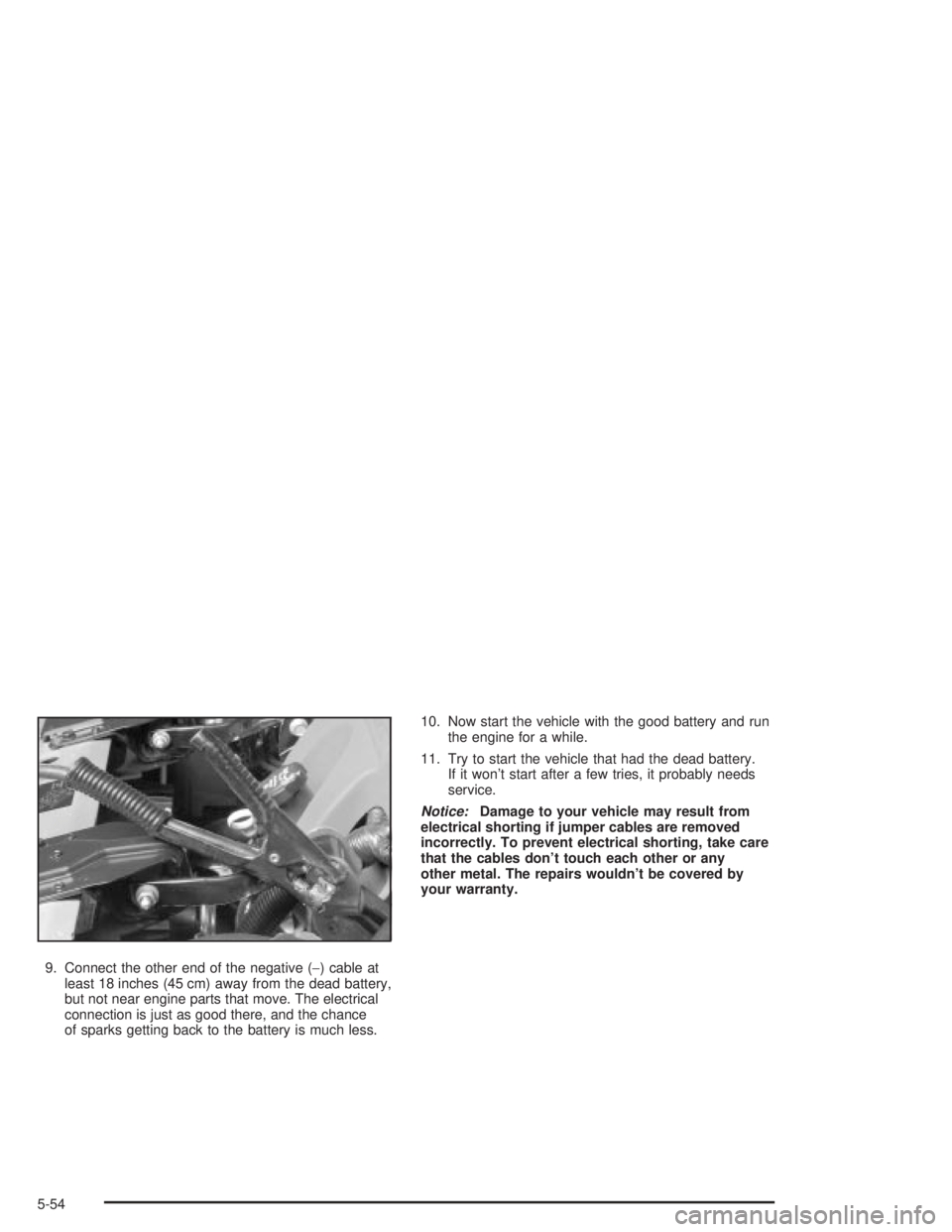
9. Connect the other end of the negative (-) cable at
least 18 inches (45 cm) away from the dead battery,
but not near engine parts that move. The electrical
connection is just as good there, and the chance
of sparks getting back to the battery is much less.10. Now start the vehicle with the good battery and run
the engine for a while.
11. Try to start the vehicle that had the dead battery.
If it won't start after a few tries, it probably needs
service.
Notice:Damage to your vehicle may result from
electrical shorting if jumper cables are removed
incorrectly. To prevent electrical shorting, take care
that the cables don't touch each other or any
other metal. The repairs wouldn't be covered by
your warranty.
5-54
Page 335 of 432
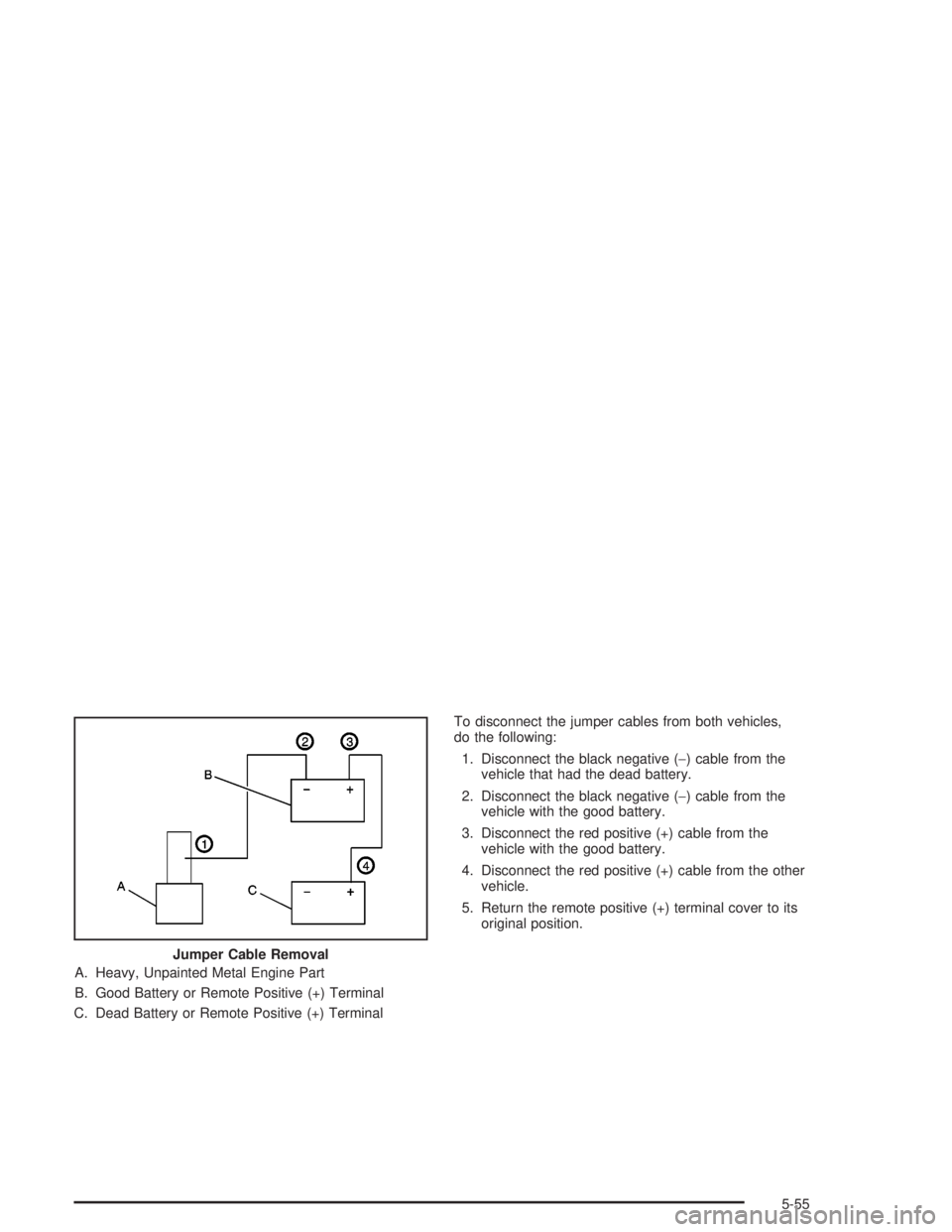
A. Heavy, Unpainted Metal Engine Part
B. Good Battery or Remote Positive (+) Terminal
C. Dead Battery or Remote Positive (+) TerminalTo disconnect the jumper cables from both vehicles,
do the following:
1. Disconnect the black negative (-) cable from the
vehicle that had the dead battery.
2. Disconnect the black negative (-) cable from the
vehicle with the good battery.
3. Disconnect the red positive (+) cable from the
vehicle with the good battery.
4. Disconnect the red positive (+) cable from the other
vehicle.
5. Return the remote positive (+) terminal cover to its
original position.
Jumper Cable Removal
5-55
Page 350 of 432
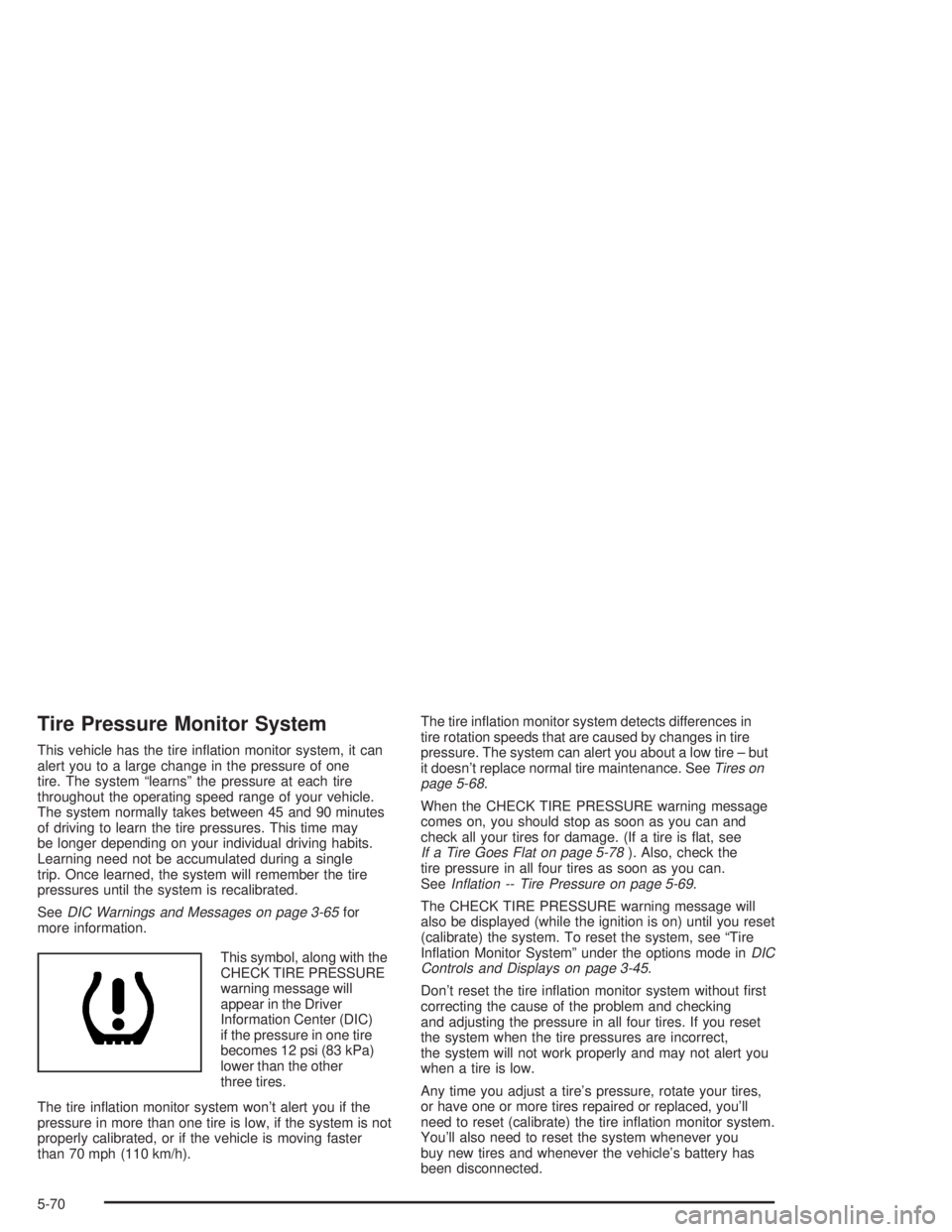
Tire Pressure Monitor System
This vehicle has the tire in¯ation monitor system, it can
alert you to a large change in the pressure of one
tire. The system ªlearnsº the pressure at each tire
throughout the operating speed range of your vehicle.
The system normally takes between 45 and 90 minutes
of driving to learn the tire pressures. This time may
be longer depending on your individual driving habits.
Learning need not be accumulated during a single
trip. Once learned, the system will remember the tire
pressures until the system is recalibrated.
See
DIC Warnings and Messages on page 3-65for
more information.
This symbol, along with the
CHECK TIRE PRESSURE
warning message will
appear in the Driver
Information Center (DIC)
if the pressure in one tire
becomes 12 psi (83 kPa)
lower than the other
three tires.
The tire in¯ation monitor system won't alert you if the
pressure in more than one tire is low, if the system is not
properly calibrated, or if the vehicle is moving faster
than 70 mph (110 km/h).The tire in¯ation monitor system detects differences in
tire rotation speeds that are caused by changes in tire
pressure. The system can alert you about a low tire ± but
it doesn't replace normal tire maintenance. See
Tires on
page 5-68.
When the CHECK TIRE PRESSURE warning message
comes on, you should stop as soon as you can and
check all your tires for damage. (If a tire is ¯at, see
If a Tire Goes Flat on page 5-78). Also, check the
tire pressure in all four tires as soon as you can.
See
In¯ation -- Tire Pressure on page 5-69.
The CHECK TIRE PRESSURE warning message will
also be displayed (while the ignition is on) until you reset
(calibrate) the system. To reset the system, see ªTire
In¯ation Monitor Systemº under the options mode in
DIC
Controls and Displays on page 3-45.
Don't reset the tire in¯ation monitor system without ®rst
correcting the cause of the problem and checking
and adjusting the pressure in all four tires. If you reset
the system when the tire pressures are incorrect,
the system will not work properly and may not alert you
when a tire is low.
Any time you adjust a tire's pressure, rotate your tires,
or have one or more tires repaired or replaced, you'll
need to reset (calibrate) the tire in¯ation monitor system.
You'll also need to reset the system whenever you
buy new tires and whenever the vehicle's battery has
been disconnected.
5-70
Page 383 of 432
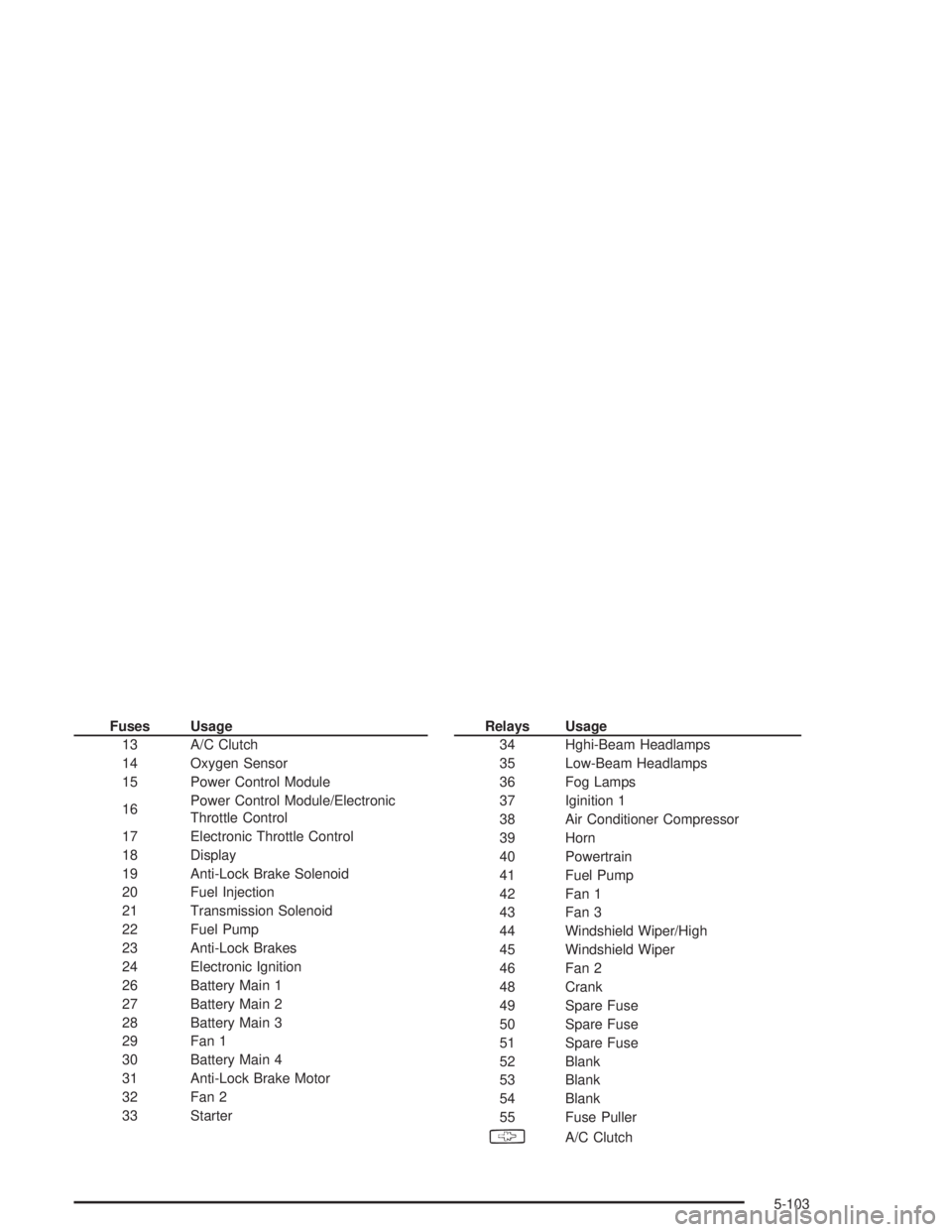
Fuses Usage
13 A/C Clutch
14 Oxygen Sensor
15 Power Control Module
16Power Control Module/Electronic
Throttle Control
17 Electronic Throttle Control
18 Display
19 Anti-Lock Brake Solenoid
20 Fuel Injection
21 Transmission Solenoid
22 Fuel Pump
23 Anti-Lock Brakes
24 Electronic Ignition
26 Battery Main 1
27 Battery Main 2
28 Battery Main 3
29 Fan 1
30 Battery Main 4
31 Anti-Lock Brake Motor
32 Fan 2
33 StarterRelays Usage
34 Hghi-Beam Headlamps
35 Low-Beam Headlamps
36 Fog Lamps
37 Iginition 1
38 Air Conditioner Compressor
39 Horn
40 Powertrain
41 Fuel Pump
42 Fan 1
43 Fan 3
44 Windshield Wiper/High
45 Windshield Wiper
46 Fan 2
48 Crank
49 Spare Fuse
50 Spare Fuse
51 Spare Fuse
52 Blank
53 Blank
54 Blank
55 Fuse Puller
§A/C Clutch
5-103
Page 418 of 432
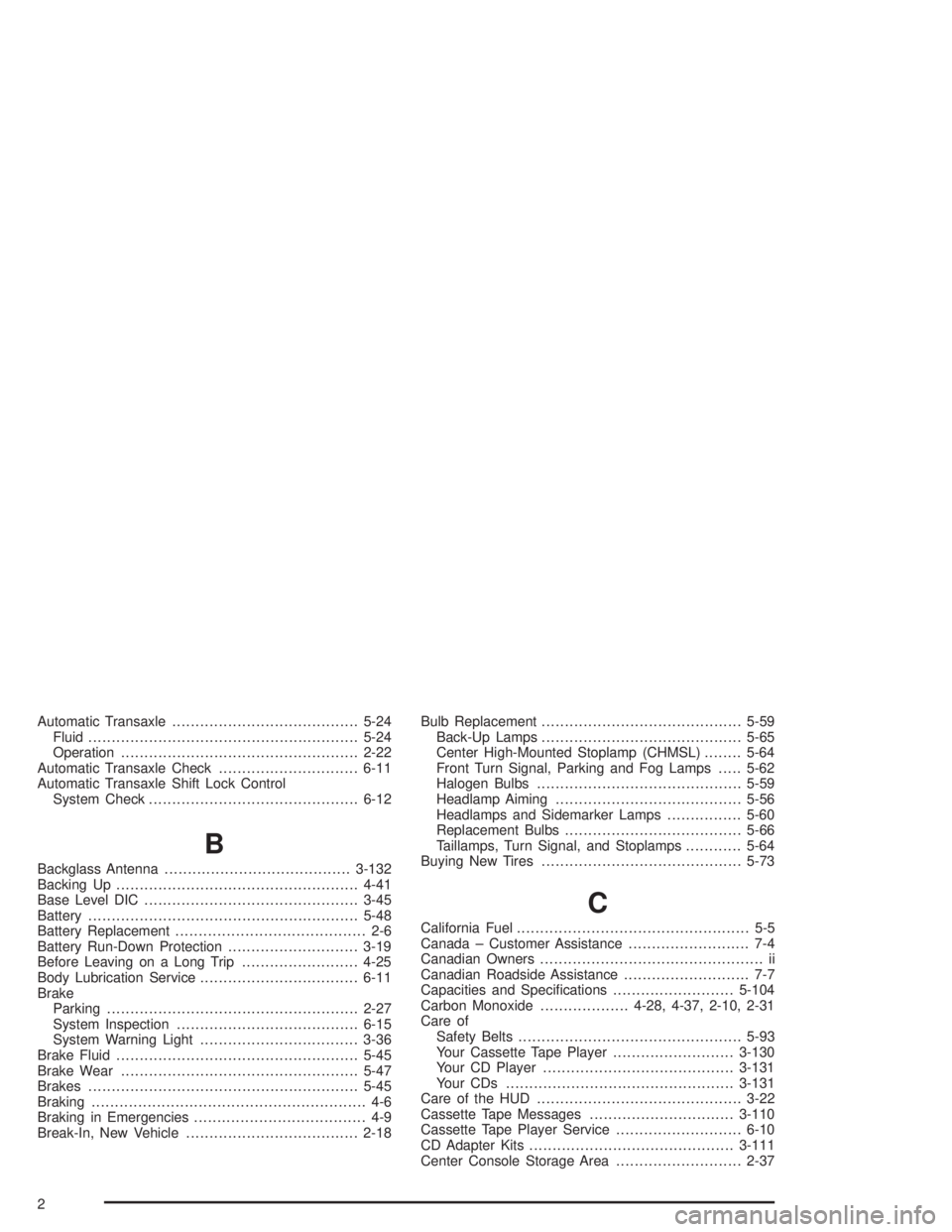
Automatic Transaxle........................................5-24
Fluid..........................................................5-24
Operation...................................................2-22
Automatic Transaxle Check..............................6-11
Automatic Transaxle Shift Lock Control
System Check.............................................6-12
B
Backglass Antenna........................................3-132
Backing Up....................................................4-41
Base Level DIC..............................................3-45
Battery..........................................................5-48
Battery Replacement......................................... 2-6
Battery Run-Down Protection............................3-19
Before Leaving on a Long Trip.........................4-25
Body Lubrication Service..................................6-11
Brake
Parking......................................................2-27
System Inspection.......................................6-15
System Warning Light..................................3-36
Brake Fluid....................................................5-45
Brake Wear...................................................5-47
Brakes..........................................................5-45
Braking........................................................... 4-6
Braking in Emergencies..................................... 4-9
Break-In, New Vehicle.....................................2-18Bulb Replacement...........................................5-59
Back-Up Lamps...........................................5-65
Center High-Mounted Stoplamp (CHMSL)........5-64
Front Turn Signal, Parking and Fog Lamps.....5-62
Halogen Bulbs............................................5-59
Headlamp Aiming........................................5-56
Headlamps and Sidemarker Lamps................5-60
Replacement Bulbs......................................5-66
Taillamps, Turn Signal, and Stoplamps............5-64
Buying New Tires...........................................5-73
C
California Fuel.................................................. 5-5
Canada ± Customer Assistance.......................... 7-4
Canadian Owners................................................ ii
Canadian Roadside Assistance........................... 7-7
Capacities and Speci®cations..........................5-104
Carbon Monoxide...................4-28, 4-37, 2-10, 2-31
Care of
Safety Belts................................................5-93
Your Cassette Tape Player..........................3-130
Your CD Player.........................................3-131
Your CDs .................................................3-131
Care of the HUD............................................3-22
Cassette Tape Messages...............................3-110
Cassette Tape Player Service...........................6-10
CD Adapter Kits............................................3-111
Center Console Storage Area...........................2-37
2
Page 421 of 432
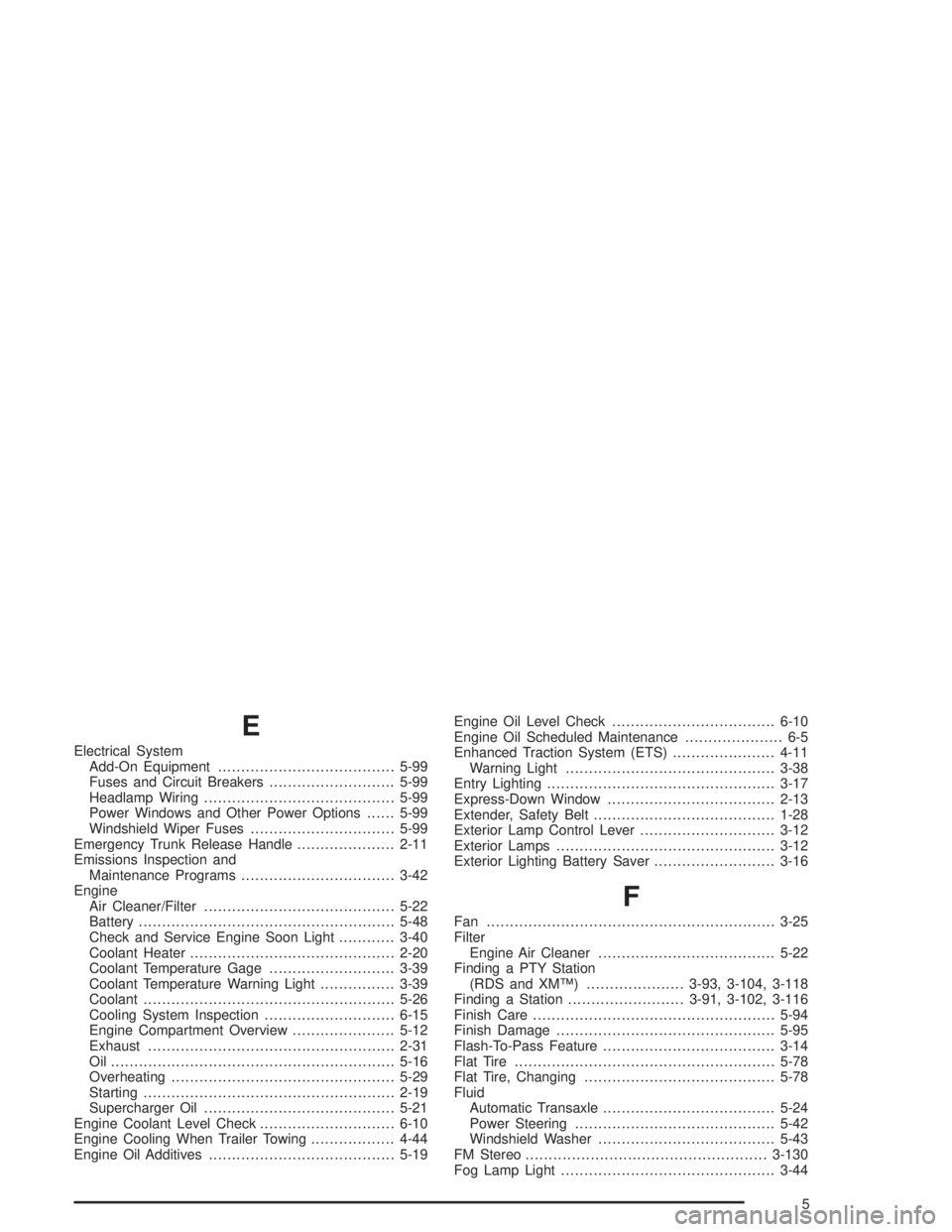
E
Electrical System
Add-On Equipment......................................5-99
Fuses and Circuit Breakers...........................5-99
Headlamp Wiring.........................................5-99
Power Windows and Other Power Options......5-99
Windshield Wiper Fuses...............................5-99
Emergency Trunk Release Handle.....................2-11
Emissions Inspection and
Maintenance Programs.................................3-42
Engine
Air Cleaner/Filter.........................................5-22
Battery.......................................................5-48
Check and Service Engine Soon Light............3-40
Coolant Heater............................................2-20
Coolant Temperature Gage...........................3-39
Coolant Temperature Warning Light................3-39
Coolant......................................................5-26
Cooling System Inspection............................6-15
Engine Compartment Overview......................5-12
Exhaust.....................................................2-31
Oil .............................................................5-16
Overheating................................................5-29
Starting......................................................2-19
Supercharger Oil.........................................5-21
Engine Coolant Level Check.............................6-10
Engine Cooling When Trailer Towing..................4-44
Engine Oil Additives........................................5-19Engine Oil Level Check...................................6-10
Engine Oil Scheduled Maintenance..................... 6-5
Enhanced Traction System (ETS)......................4-11
Warning Light.............................................3-38
Entry Lighting.................................................3-17
Express-Down Window....................................2-13
Extender, Safety Belt.......................................1-28
Exterior Lamp Control Lever.............................3-12
Exterior Lamps...............................................3-12
Exterior Lighting Battery Saver..........................3-16
F
Fan ..............................................................3-25
Filter
Engine Air Cleaner......................................5-22
Finding a PTY Station
(RDS and XMŸ).....................3-93, 3-104, 3-118
Finding a Station.........................3-91, 3-102, 3-116
Finish Care....................................................5-94
Finish Damage...............................................5-95
Flash-To-Pass Feature.....................................3-14
Flat Tire........................................................5-78
Flat Tire, Changing.........................................5-78
Fluid
Automatic Transaxle.....................................5-24
Power Steering...........................................5-42
Windshield Washer......................................5-43
FM Stereo....................................................3-130
Fog Lamp Light..............................................3-44
5
Page 423 of 432
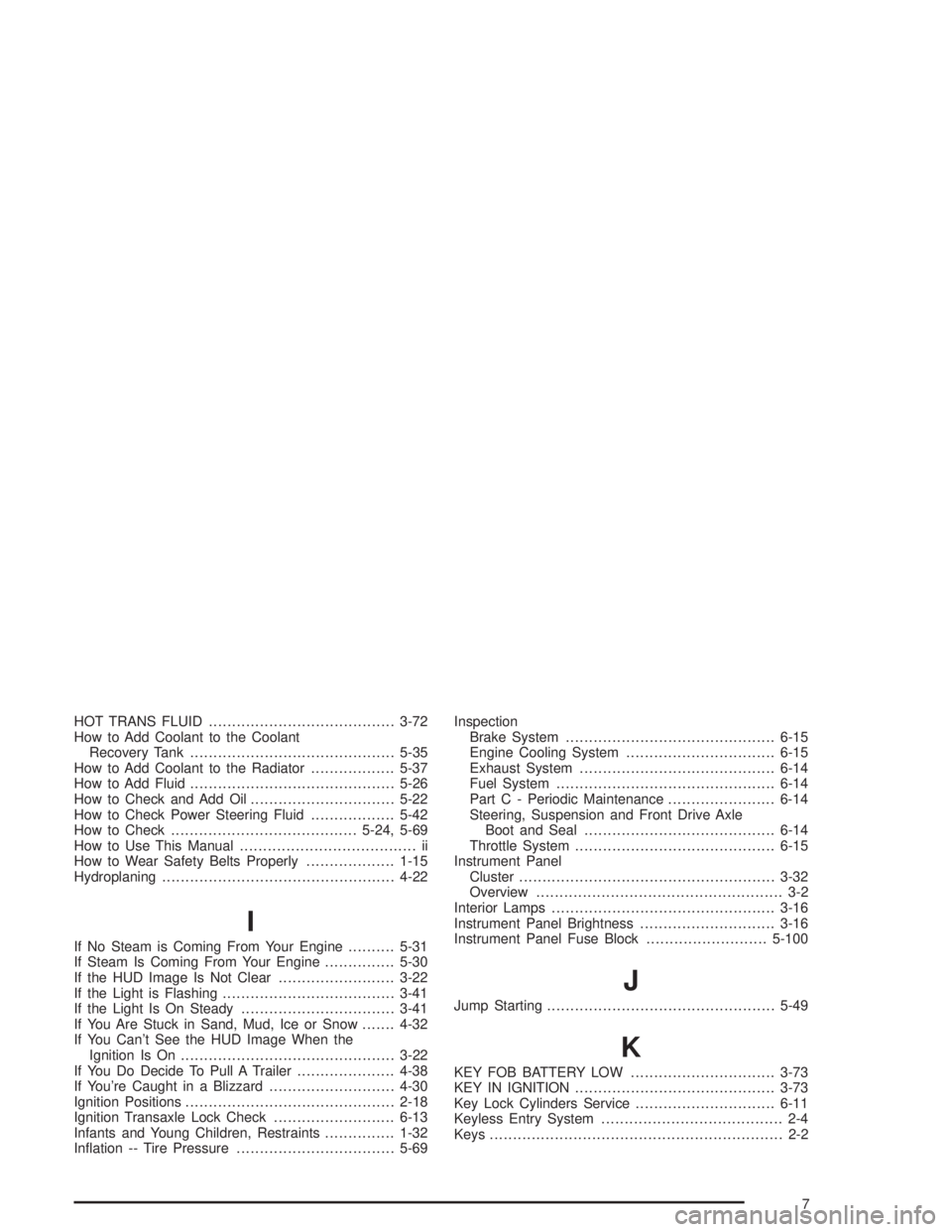
HOT TRANS FLUID........................................3-72
How to Add Coolant to the Coolant
Recovery Tank............................................5-35
How to Add Coolant to the Radiator..................5-37
How to Add Fluid............................................5-26
How to Check and Add Oil...............................5-22
How to Check Power Steering Fluid..................5-42
How to Check........................................5-24, 5-69
How to Use This Manual...................................... ii
How to Wear Safety Belts Properly...................1-15
Hydroplaning..................................................4-22
I
If No Steam is Coming From Your Engine..........5-31
If Steam Is Coming From Your Engine...............5-30
If the HUD Image Is Not Clear.........................3-22
If the Light is Flashing.....................................3-41
If the Light Is On Steady.................................3-41
If You Are Stuck in Sand, Mud, Ice or Snow.......4-32
If You Can't See the HUD Image When the
Ignition Is On..............................................3-22
If You Do Decide To Pull A Trailer.....................4-38
If You're Caught in a Blizzard...........................4-30
Ignition Positions.............................................2-18
Ignition Transaxle Lock Check..........................6-13
Infants and Young Children, Restraints...............1-32
In¯ation -- Tire Pressure..................................5-69Inspection
Brake System.............................................6-15
Engine Cooling System................................6-15
Exhaust System..........................................6-14
Fuel System...............................................6-14
Part C - Periodic Maintenance.......................6-14
Steering, Suspension and Front Drive Axle
Boot and Seal.........................................6-14
Throttle System...........................................6-15
Instrument Panel
Cluster.......................................................3-32
Overview..................................................... 3-2
Interior Lamps................................................3-16
Instrument Panel Brightness.............................3-16
Instrument Panel Fuse Block..........................5-100
J
Jump Starting.................................................5-49
K
KEY FOB BATTERY LOW...............................3-73
KEY IN IGNITION...........................................3-73
Key Lock Cylinders Service..............................6-11
Keyless Entry System....................................... 2-4
Keys............................................................... 2-2
7